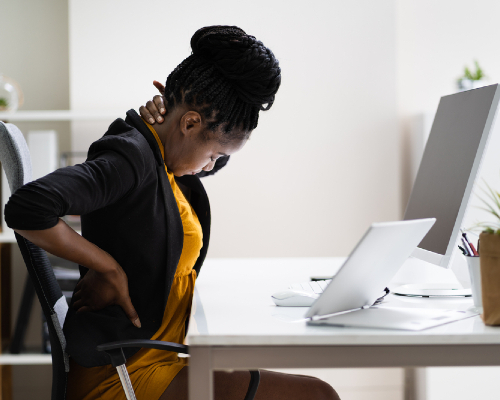Slouching in a chair, with a forward head posture, has long been blamed by healthcare professionals and yoga and pilates teachers as a cause of neck and back pain. As well as promoting the importance of good posture while sitting, standing, squatting or lifting, these professionals stress the importance of having a good symmetry of body for optimal performance.

What does science say about it?
This might be surprising but, scientifically, there is no good or bad posture. Nor is there any association between posture and neck or back pain.
In fact, in a research paper published in 2010, the osteopath Dr Eyal Lederman states that people who typically sit in awkward postures do not have a higher level of back pain. These conclusions are backed up by many other previous studies. Further recent research studies state that:
- Asymmetries in the body are not abnormalities and are actually extremely common
- There is no “good” or a “bad” posture. Only a position that is comfortable for an individual
- Slouching can be okay!
- Sitting with legs crossed is okay as well
- Tissue damage does not equal pain
Have you tried sitting up straight as most people recommend? How difficult and tiring is that? Can you maintain that posture for an eight-hour shift?
So if the way we sit is not relevant to neck or back pain, what should we do to prevent it?
Aches and pain are normal experiences that every human being will have at some point in life. Like catching colds – we all get them, and it’s not surprising when we do. In most cases they last a few days and are of little disturbance, while in other cases symptoms might be more annoying.
While we cannot eliminate pain from our life, there are many things we can do to significantly reduce the likelihood of developing pain. Extensive research has been carried out on this issue and the conclusions are:
- Taking part in physical activities such as walking, climbing stairs, swimming, running, lifting weights, cycling or playing tennis. These all count towards the UK’s physical activity guidelines, which recommend individuals take part in at least 150 minutes of moderately intense activity per week or 75 minutes of vigorously intense activity each week.
- Seven to eight hours of good-quality sleep is essential for many aspects of our health, including neck and back pain
- Having a balanced diet, limiting alcohol intake and avoiding smoking are all beneficial for a healthy spine
- It is enormously helpful to keep stress levels under control. Commuting to work, long working hours and difficult working and home environments are often stressors that we cannot entirely change. It’s worth considering strategies such as mindfulness meditation to find happiness and stillness within.
Further information
Our team of physiotherapists are specialists in treating people with low back and neck pain and we work alongside a team of dieticians, psychologists and occupational therapists to help you develop individualised, bespoke strategies to address all of these factors.
To make a Physiotherapy appointment, please contact the department on +44 (0)20 7616 7651.
Disclaimer
Any views expressed in this article are those of the featured specialist(s) and should not be considered to be the views or official policy of The London Clinic.